 Once in a while I get a response to a blog post that really merits its own stand-alone blog. Lauren sent me a response to my blog addressing the ethics of horseback riding, and while she doesn’t agree with my conclusion, I think she raises some interesting points and introduces several new arguments. So I wanted to present her post, which she took a lot of time to compose, along with my rebuttal arguments.
Once in a while I get a response to a blog post that really merits its own stand-alone blog. Lauren sent me a response to my blog addressing the ethics of horseback riding, and while she doesn’t agree with my conclusion, I think she raises some interesting points and introduces several new arguments. So I wanted to present her post, which she took a lot of time to compose, along with my rebuttal arguments.
LAUREN’S POST:
“This is long so please bare with me:
Hi Heather, my name is Lauren and I came across your blog post today while doing some research. I am a soon-to-be graduate of Purdue University, am a vegetarian for multiple reasons, and rode horses for 15 years before changing my entire viewpoint on riding.
I have ridden in both English and Western disciplines and was once a rated member of the United States Pony Club. I have raced barrels, hacked Saddlebreds, ridden in Western pleasure classes, ridden trails, competed in dressage, and jumped cross-country. I have probably ridden over 100 horses (I am not joking) from ponies to ex-racehorses. I have also had many different riding instructors over the years including so-called professional riders. I used to attend the Rolex Three Day event in Kentucky every Spring and thought that somehow my poor (seriously) self would find an opportunity to become a professional eventer with some off-the-track-Thoroughbred I’d bought for $300. Then one day I literally walked away from it all and I have not looked back since.

The cross country portion of the “triathlon” is the most extreme equestrian sport, pushing horses and riders often beyond their physical and mental limits.
Last September, I saw an article pop up on my Facebook about the organizers of a three day event changing part of a cross-country course half way through the order-of-go. Apparently many of the horses and riders had been having problems at particular jumps due to poor weather conditions. So I posted the article to my feed with a statement that this was unfair because most of the professional riders at the event were at the end of the running order and would now be riding a different if not easier course than the novice riders that went before them. I got some backlash from fellow riders who said the organizers were correct to look out for the “safety” of the other riders once they realized there were too many problems. I insisted that this still wasn’t fair because the riders at the end were more experienced and should know how to “handle” the poor conditions. Still, there were arguments that this change of course was proper for safety. A little angered, this time I pointed out that the whole sport of eventing is dangerous and horses can die. They do die. I was at Rolex just across the field in 2008 when Lainey Ashker’s Frodo Baggins went down over the now-infamous Flower Basket jump. Horses die in this sport all the time and yet we never once ask the horse if he’d rather not go out there and risk his neck for it.
So I began to think about this some more. I’m no physicist, but I realized that any time a mistake is made at a jump it is always the rider’s fault. This is due to the fact that the horse is in no way “designed” to carry a rider (living organisms do not have a defined purpose and neither do their parts; see Diamond v. Chakrabarty which alludes to this legally, and check out the NIH’s stance on this). Any minimal shift in the rider’s weight (which is going to happen), shift of the tack (which is also going to happen) or otherwise (a random act of nature, i.e. shifting of wind or terrain) can and will throw the horse off-balance. In addition, any perceived “wrong” move taken by the horse in response to the shifting of his balance or active response to shifts in the rider’s weight are often punished by use of the crop and/or spurs. Typically, what the horse is really doing is making an active judgment of the situation to account for rider error (i.e. the shifting of the rider’s weight). Again, I don’t have science to back me up here, but I would hypothesize that the movement the horse would make on a cross-country course, such as an approach to a jump, would almost always be different from the movements made by the horse with a rider on its back. To complete the example, if you have a horse and rider approach a jump and he suddenly refuses or lunges to the side to go around the jump, he has made a judgment call that he could not safely make the effort without injuring himself. And for this the horse often receives a whack with the whip, a jab of the rider’s spurs, and/or a nasty yank of the reins. The horse made an effort to protect himself – to survive – and he received punishment.
I don’t believe any horse on this planet would go out and run an XC course of his own accord in the absence of a rider. Horses can certainly jump, but I would like to think that they do so out of necessity rather than finding joy in it (I’m not talking about a horse jumping a random log in the middle of the field on his gallop back to the barn for evening chow, which is still technically necessity anyway – jumping the log might be the fastest way to the barn). I know horses a little bit and I had ridden them for many years – I just don’t think they would jump an entire cross-country course without the guidance of a rider for what humans call “fun.”

An average of 24 racehorse deaths every year in the US – approximately 2,000 horses break-down and have to be vanned-off at tracks.
Further, if these event riders have such great partnerships with their horses, why exactly do they need whips, spurs, and/or bits? Some go “nice in a snaffle,” but I’ve seen gags, pelhams, and elevators on the cross-country horse, as well as different lengths of spurs on the rider’s boots and different types of crops in the rider’s hands. I have been to many upper level and lower level cross-country events and at least once I have seen a rider “get rough” with these “aids” in some manner. It isn’t acceptable. We could argue about “good” contact all day, but my question still stands: what are the spurs, whips/crops, and bits for if you have such a good partnership with your horse?
Why would you ever need those things to “communicate” “jump this massive fence at a gallop with me on your back?” Perhaps it’s because in the absence of these “aids” the horse would have a much easier time of saying “no” and there goes the “connection” between man and horse.
I watched the video and read the Tumblr entry you discussed in your post. Based on the definition of “vegan,” a person who follows this philosophy does not consume any animal products for any reason in any manner whether that is strictly for ethical, health, or other reasons. Hence, riding is not vegan because a human being would be taking something from the horse (energy, a place to sit, engaging the horse as a vehicle for transportation, etc.) and the horse rarely gets anything positive from the experience of being ridden. The viewpoint is clear and there isn’t anything inherently wrong with it either. If there is something inherently wrong with not riding a horse because it is unnecessary or unethical or whatever, please enlighten me.
I am not vegan and though I do not ride anymore for the reason that it is harmful to the horse’s well-being, believe me when I say I miss riding horses. I grew up riding and it is something that’s ingrained in my soul for better or for worse. But I have learned that to ride a horse is selfish on my part. I don’t need to ride a horse for any other reason than enjoyment. And when there is overwhelming research to show that riding can harm the horse physically, physiologically, emotionally, mentally, and/or psychologically what reason is there that justifies riding? I do not believe that the research snippets in the video are incorrect even if they may need some more fleshing-out and additional research.
I am vegetarian and I do not necessarily equate not eating meat with not riding. However, I think that equestrian competition is exploitation of the horse for human gain at the cost of prohibiting the horse from expressing free will to not participate (and not be punished for the refusal). Competition impacts the horse negatively in many respects and should not be supported. Absolutely any equestrian competition is harmful to the horse.

There should never be a situation where, if a fence is not ridden or jumped perfectly, the horse does a rotational fall.
Let me take your pet or dog ownership thoughts into account as well. So we say our animals love us, yeah? So same thing as above with the spurs, whips and bits on horses, why do we need leashes and collars for dogs? (I would concede that typically the leash and collar aren’t used in the same manner as the bit and spurs, but that they can be used with severity.) If humans had true partnerships with their dogs (and some do) then we shouldn’t need leashes or collars. When you get down to the bare minimum of the uses for the items used on a horse and the items used on a dog they are each used in a manner consistent with control of the animal. The leash and collar keep the dog from running off and the bit, whip and spurs force the horse to do our bidding when we get on his back.
Further, just because horses could carry 25% of their bodyweight on their back (by what study by the way?) does not mean it is designed to do so. Again, living beings are not designed for a purpose. Do you even know exactly why you exist on earth? I can’t even pretend to know that. Studies have also shown that when a horse bares a rider on its back for more than 15 minutes of work this can cause the horse immediate soft tissue damage and pain. If you know of a study that cleanly refutes this please post it. Please refer to the Nevzorov Haute Ecole’s website for information on the study I noted here.
While “going for a trail ride” hardly sounds like abuse, if the horse doesn’t have a choice in the matter then this doesn’t make it ok. Just because you don’t think you’re harming the horse does not mean that you aren’t. If you love and cherish your horse why would you take this risk?
In the “death to carnism” blog, the author does not advocate turning horses loose in the wild. The author states that this would be irresponsible. That is another discussion for another time as well.
You’re right about humans harming other animals no matter what considering the world we live in, but this is not a free pass to just hop on a horse and ride it. That’s a hypocritical point  of view. If you know you are harming the horse, why would you ride it? If you don’t know, you shouldn’t ride, and you should study-up.
of view. If you know you are harming the horse, why would you ride it? If you don’t know, you shouldn’t ride, and you should study-up.
Just because PETA thinks it’s ok to ride horses does not make it suddenly ok to do so. This organization has been discredited on many fronts for many different reasons. Take a look at this Huffington Post opinion piece from 2013 if you are certain you support them: http://www.huffingtonpost.com/nathan-j-winograd/peta-kills-puppies-kittens_b_2979220.html. (I am not saying they are entirely horrible because I really just don’t know. But I’m willing to bet since the Huffington Post still has this up on their website they haven’t lost a lawsuit on facts.)
Finally, if we humans must abide by “consent,” as in, “no, means no,” but we do not afford this to other animals for one reason or another than as humans we are taking a step backwards. No one being is superior to others – they all need to exist for this planet to be whole. In addition, though I am not a representative for Alexander Nevzorov’s Haute Ecole, I understand that while he did ride horses for a while he did so without the use of any restraint of the horse’s head. Since that time he has expressed that he feels riding is unethical altogether and does not teach riding or condone it. Instead he teaches a way to have a meaningful relationship with the horse on the ground without pain or force at all.”
First I think we need to define what veganism is – the practice of abstaining from the use of animal products. Some vegans have taken to extending their philosophy in all manner of ways in which the originator cannot have foreseen. I can’t imagine how we can consider the “energy” of a horse as a product of that animal unless that is what one understands to be covered by “ethical veganism.” Vegetarians on the other hand, still consume some animals products, including dairy, eggs, cheese, gelatin, honey, etc. I have to say honestly that I am baffled as to why taking “energy” from a horse seems to be so objectionable to you while consuming dairy or eggs is apparently less so. The demand for dairy has very tangible effects on the cows and calves in that industry, and chickens suffer immensely to produce eggs, much more easily measurable and quantifiable than any presumptive abuse to horses resulting from conventional riding.
I do want to affirm a lot of what you’ve written about various horse sports being cruel or inhumane to horses. I do agree that the cross-country phase of eventing at both the international level or at Pony Club are highly dangerous, along with other “sports” such as racing, rodeo, chuckwagon races, jumps racing, and numerous cultural events are all either blatantly cruel to horses or stretch them beyond their reasonable capabilities. I wrote more about the broad abuses of horses in another blog post. Cross-country courses challenge horses with drop fences, where the horse can’t anticipate that he has to leap straight down, and water jumps compel horses to jump then while not knowing the depth. Until recently, obstacles did not break-away, causing serious falls and injuries (if not death) to both horse and rider. Courses are, IMO far too long and even when horses are matched to an ideal course, they can only run and jump for so long before they are exhausted or injured. Any event where you have significantly less than 100% of the participants fail to complete a course is too strenuous and risky.
We know that not all high-level riders in all disciplines ride with empathy, as shown in the following video:
I don’t agree with you that whenever a mistake is made on a course it is rider’s error. Even a correctly balanced rider’s weight causes the horse to strain to overcome gravity. The horse needs greater impulsion to clear the weight over the fence, possibly over-extending himself on the other side of the jump. A tired horse builds up lactic acid in his muscles and is more likely to sustain injury. Horses can also dehydrate and tie-up even with the most competent riders. I did actually link to a study in the original blog post that concluded that healthy, fit horses could comfortably carry up to 25% of their body weight (saddle and rider) which supports my contention that horses are not physically compromised by the weight of most riders. The ability of an animal to lift weight (whether ant, cockroach, or horse) is determined by the relationship between surface area and body mass. Ants can also lift 50 times their own weight even though they might not need to. Obviously, other factors to consider in matching the horse to the sport are size and weight, condition, fitness, conformation, attitude, ability of a saddle to distribute weight properly, ability and weight of the rider, distance travelled while riding, type of terrain, and temperature/weather conditions.
 Whips, spurs and bits are not automatically torturous. I don’t use spurs and I don’t think most riders do either. I don’t use a whip except in driving where it must be carried in case the horse backs up into a hazard such as a car, child, or edge or a ravine. The driving whip is used to take the place of the leg aid and is used to signal that a bend is asked for or a change of direction is forthcoming. The floppy end of a driving whip taps the horse with the same pressure as flicking a shoelace on your arm. And if you’re going to have a bit there is a range that are considered good and humane by most riders and clinicians. I don’t believe that halters cause a horse any pain. Most higher level dressage riders use spurs subtly, but their use by less skilled riders is apt to be punitive or abusive.
Whips, spurs and bits are not automatically torturous. I don’t use spurs and I don’t think most riders do either. I don’t use a whip except in driving where it must be carried in case the horse backs up into a hazard such as a car, child, or edge or a ravine. The driving whip is used to take the place of the leg aid and is used to signal that a bend is asked for or a change of direction is forthcoming. The floppy end of a driving whip taps the horse with the same pressure as flicking a shoelace on your arm. And if you’re going to have a bit there is a range that are considered good and humane by most riders and clinicians. I don’t believe that halters cause a horse any pain. Most higher level dressage riders use spurs subtly, but their use by less skilled riders is apt to be punitive or abusive.
You claim that there is overwhelming research that riding harms horses “physically, physiologically, emotionally, mentally, and/or psychologically?” You didn’t provide any evidence for this to prove your point. I have seen some vegan sites post a link to research that consisted of evaluating a horse’s back for Kissing Spine, otherwise known as impinging spinal processes in the back, which is largely congenital. One vegan blogger cited it as a condition she assumed was directly caused by riding. I tried to correct the assumption, but it seems she was too cowardly to moderate my post. Impinging spinal processes need to be evaluated to determine whether a horse can be ridden, and as you know, horses will absolutely tell you when they are in pain.
Humans are self-legislative, morally autonomous beings. It does not follow from this that we are morally free to do anything we please to animals. However, if we required permission from  an animal to take any action on their behalf then we could not spay or neuter them, walk them on leashes for their own safety, nor could we anaesthetize them to clean their teeth, vaccinate them, keep them on leashes safe from traffic, trim their hooves, or euthanize them when terminally ill. If we choose not to do any of these things because we don’t have permission, then we’re missing the point of being ethical and compassionate human beings.
an animal to take any action on their behalf then we could not spay or neuter them, walk them on leashes for their own safety, nor could we anaesthetize them to clean their teeth, vaccinate them, keep them on leashes safe from traffic, trim their hooves, or euthanize them when terminally ill. If we choose not to do any of these things because we don’t have permission, then we’re missing the point of being ethical and compassionate human beings.
Alexander Nevzorov is simply another clinician, one who has attracted a cult following. Quite frankly, he makes my head explode. Because he has attracted extremists, he thrives in that environment and turns off people who are interested in his methods but not the extremist attitude. He and his followers won’t allow discussion of other methods. He is in favour of abolishing equine use (and equines) period. There are a number of other things that Nevzorov is also quite strident about that do not fit with my concept of good and ethical horse welfare. His videos depict all the worst aspects of riding that many horse people would like to abolish – racing, rollkur, over-horsed riders balancing themselves on the bit, sometimes with nervous, perhaps improperly trained horses, rodeo, etc. The videos imply that this is the norm.
Nevzorov and his wife are even opposed to improvements in horse sport because to them it means they won’t be able to abolish it as soon as they would like. This is rather comparable to being opposed to the discontinuation of gestation crates for pigs while waiting and hoping that people will stop eating meat. They are opposed to the use of the Dr. Cook bitless bridle. They also have no interest in rescuing horses, possibly since they feel that the sooner horses become extinct as a species, the better. They are opposed to any breeding of horses at all, which again means in their world the domesticated horse is an extinct horse.
You make the assumption that before he stopped riding horses he rode without confining the horse’s head with a bridle. This is not true. Nevzorov rode horses in the traditional manner with saddle and double bridle. There are numerous pictures of him on the web using traditional horse tack which often included whip and spurs. What most of his followers don’t know is that the horses you see him performing with were all trained traditionally under saddle and with a double bridle, whip, and spurs. If he can accomplish the same level of training with a totally green horse and without resorting to any other methods but what he’s condoning now, I’d be impressed. While I agree with many of his statements about whips, harsh bits, rough handling, etc. he claims to have taught his horses to understand Latin (which is really a written rather than spoken language). This is crackpottery of the highest order.
 Few if any people will listen to him and quit riding horses to work exclusively in hand with them. No one will pay to board a horse only to walk it on a lead, thinking they can teach it Latin. No one is going to build an arena and house horses in it to watch them self-collect. Amazingly though, Nevzorov, his wife and their followers all believe that the equine industry would continue on and develop in the same way, but with non-ridden horses. He also claims that it is “legally acceptable to claim moral damage which is caused to children, who’s mental health is endangered while participating in “sport activities” which considers the cruel treatment of a living being to be normal.”
Few if any people will listen to him and quit riding horses to work exclusively in hand with them. No one will pay to board a horse only to walk it on a lead, thinking they can teach it Latin. No one is going to build an arena and house horses in it to watch them self-collect. Amazingly though, Nevzorov, his wife and their followers all believe that the equine industry would continue on and develop in the same way, but with non-ridden horses. He also claims that it is “legally acceptable to claim moral damage which is caused to children, who’s mental health is endangered while participating in “sport activities” which considers the cruel treatment of a living being to be normal.”
PeTA’s endorsement of horse riding is relevant since they are probably the most radical of the major animal rights/welfare groups (ASPCA/HSUS/MFA etc). Some of Nathan Winograd’s Huffington Post pieces have been shared over 100,000 times by many people who never question the veracity of his claims about PeTA. The “PeTA Kills Animals” phenomenon was a hoax perpetrated by the Center for Consumer Freedom, a deceitful outfit that protects the interests of animal enterprise industries. They created the hoax to mitigate PeTA’s impact on their meat and biomedical industry clients’ profit margins. Not so admirably, others have jumped on the “PeTA Kills Animals” bandwagon to mitigate that organization’s impact on their agendas. Nathan Winograd falls into this category. Rather than address head-on PeTA’s concerns about dangerous and ineffective “No Kill” initiatives, Winograd uses the “PeTA Kills Animals” meme to change the conversation. Unfortunately, for animals in many “No Kill” shelters and rescues, PeTA’s concerns that the “No Kill” movement is causing them harm appear to be valid.
The “Why PeTA Euthanizes” website has compiled detailed information on PeTA euthanization and exposes Nathan Winograd as someone who takes liberty with the truth. Indeed, Winograd spends far more time critiquing other animal welfare organizations than he does in promoting No Kill. It’s a fact that nearly every animal PeTA has euthanized was admitted into their care by their owner. Virginia (home of PeTA’s shelter) shelter stats are public information. PETA’s shelter reporting data is freely available online, despite Winograd’s classification of these records as “secret.” This shelter is one of last resort and they offer no-cost euthanasia in the impoverished area their shelter serves. This video, produced by PETA last year, goes into quite some detail about the animals they served in their shelter in 2013. Mary Tully, the curator of the “Why PeTA Euthanizes,” site, writes:
“The small, hands-on facility at PeTA’s Norfolk headquarters isn’t a traditional animal shelter, but by comparing it to one, PeTA’s detractors are able to make it seem like PeTA’s euthanasia “numbers” are very high and somehow very bad. PeTA’s shelter operates for the primary purpose of providing no-cost, humane, veterinarian-supervised, medical euthanasia to suffering community animals who require it. This service is offered on an emergency on-call basis only, and it’s not advertised in any way.
PeTA’s Virginia Department of Agriculture and Consumer Services animal reporting data and shelter inspection reports confirm that nearly every animal PeTA receives for euthanasia is received from his or her guardian for this service. There is no indication that these guardians aren’t acting in their animals’ best interests by requesting this service from PeTA’s shelter, or that it’s in any of their best interests not to be immediately euthanized.
Though Virginia veterinarians may offer the service of owner-requested euthanasia to the public, the fees are simply out of reach for many Hampton Roads citizens. The average cost of veterinarian-provided euthanasia in the area, as of this writing, is $25 per pound of animal body weight, not including additional costs for cremation services. Affordable Veterinarian Services of Virginia’s fees start at $295 for the procedure itself, with an additional fee of $132 for their cremation service.
Virginia’s State Veterinarian, Dr. Dan Kovich, DVM, MPH, acknowledged the gap, during our recent interview. “There are several communities that are underserved by veterinarians, or don’t have access to a veterinarian at all,” Kovich stated. “Shelters that offer owner-requested euthanasia are providing a valuable service to the community,” he further explained.
Most of PeTA’s community work involves helping to improve the quality of life for outdoor dogs and keeping community animals who are in good homes, in those good homes. PeTA served over 6,000 outdoor dogs last year in ways that were meaningful to them. Because PeTA never takes custody of those animals, they aren’t accounted for in their state animal reporting data. Neither are the over 11,000 community animals PeTA spayed and neutered last year in their free and low-cost mobile clinics. PeTA served over 17,000 animals in 2013 who went on to have happy, healthy lives, but because they don’t appear on the animal reporting summaries, they’re unfairly absent from conversations about the work PeTA does.”
Winograd was so deceptive in his HuffPo articles on PeTA, that he was served with a Cease and Desist letter. Similarly, another Huff Po Blogger who wrote extensively and critically of PeTA, Douglas  Anthony Cooper, also acknowledges receiving a C&D. PeTA also took action against posters hiding behind anonymous profiles libelling them on HuffPo, which may have contributed to HuffPo’s decision to abandon anonymous commenting on their site in favour of the Facebook social plug-in. In short, there is little reliable information about PeTAs practices to be found on the Huffington Post at all.
Anthony Cooper, also acknowledges receiving a C&D. PeTA also took action against posters hiding behind anonymous profiles libelling them on HuffPo, which may have contributed to HuffPo’s decision to abandon anonymous commenting on their site in favour of the Facebook social plug-in. In short, there is little reliable information about PeTAs practices to be found on the Huffington Post at all.
So Lauren, my belief is that one should ride lightly, cue as lightly as possible, less is more, and critical thinking needs to be employed when reading these articles. When people specialize in extremism, they expend massive energy in conflict with other groups who are quite close to their ethical position: they are fighting over the little things, and losing the battle against the rest of the world. This is true for both Nevzorov and Winograd. I don’t know about Nevzorov, but try politely disagreeing with Winograd on his Facebook page and he will lecture and then ban you immediately. That’s one reason Parelli and Rashid and other clinicians are so successful – we may not like all of their teachings but they preach to the middle of the roadists. Whoever captures the middle ground will have the greatest support base and opportunity to improve conditions for horses. The extreme groups are left to fight over the margins. Nevzorov and Winograd both have valid points, but I’m not interested in personality cults.
Cheers, He@ther




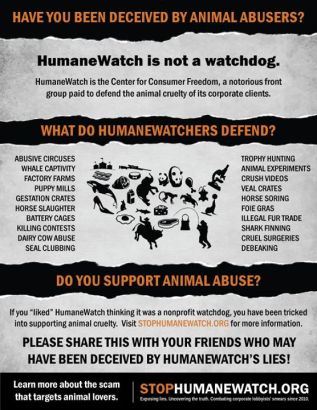



































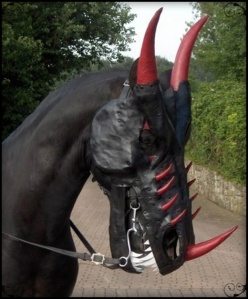




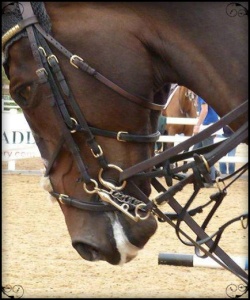



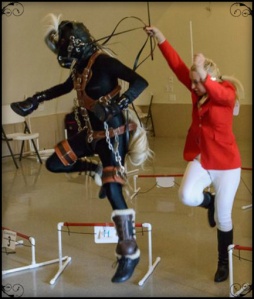





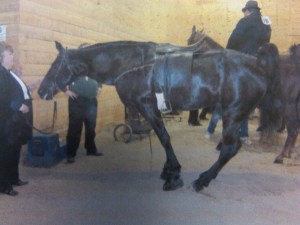













 Written by: Amanda Katz (Guestblogger Extraordinaire)
Written by: Amanda Katz (Guestblogger Extraordinaire) regarding dogs rescued from fighting operations, your description of the HSUS position does not include the fact that
regarding dogs rescued from fighting operations, your description of the HSUS position does not include the fact that  Gas chamber and Michael Vick
Gas chamber and Michael Vick












